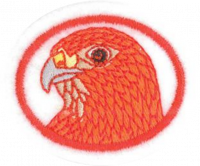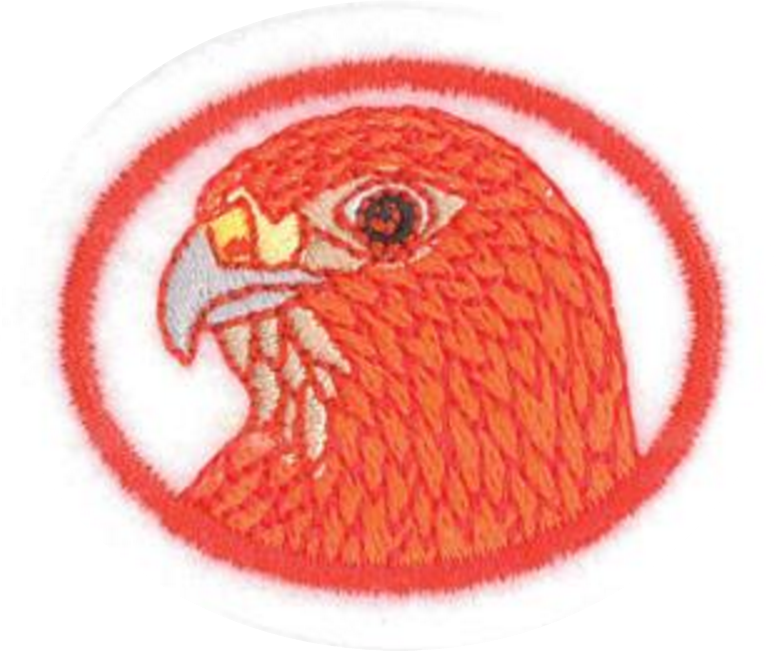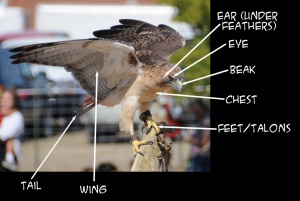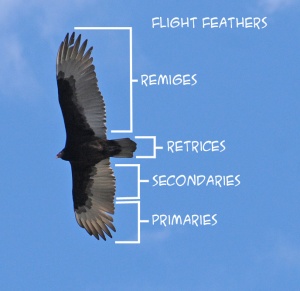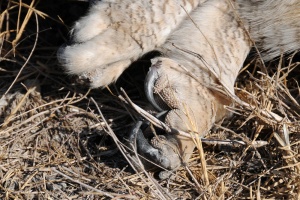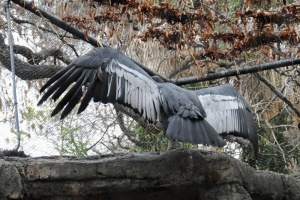Difference between revisions of "AY Honors/Raptors/Answer Key/es"
(Created page with "</noinclude> <!-- 1. ¿Qué significa la palabra «rapiña»? -->") |
|||
| (21 intermediate revisions by 2 users not shown) | |||
| Line 5: | Line 5: | ||
<!-- 1. ¿Qué significa la palabra «rapiña»? --> | <!-- 1. ¿Qué significa la palabra «rapiña»? --> | ||
| − | + | La palabra rapiña proviene de la palabra latina ''rapere'', que significa «apoderarse» o «tomar por la fuerza». El término se usa en referencia con la forma en que muchos raptores matan a su presa con sus pies. | |
| − | + | Las aves rapaces incluyen halcones, águilas, milanos, buitres, cóndores, halcones, búhos y el secretario. Las aves rapaces a menudo se conocen como aves de presa, ya que con frecuencia son cazadores activos (aparte de los buitres y los cóndores, que son principalmente los comedores de carroña). Una característica común entre las aves rapaces son sus garras afiladas y curvas para atrapar y mantener presa, su pico superior curvado para desgarrar la carne, y con frecuencia su aguda vista, audiencia y/o sentido del olfato, utilizado para encontrar su comida. | |
<noinclude></noinclude> | <noinclude></noinclude> | ||
{{CloseReq}} <!-- 1 --> | {{CloseReq}} <!-- 1 --> | ||
{{ansreq|page={{#titleparts:{{PAGENAME}}|2|1}}|num=2}} | {{ansreq|page={{#titleparts:{{PAGENAME}}|2|1}}|num=2}} | ||
| − | <noinclude> | + | <noinclude></noinclude> |
| − | </noinclude> | + | <!-- 2. Clasificación: --> |
| − | <!-- 2. | + | <noinclude></noinclude> |
| − | <noinclude | ||
| − | |||
{{ansreq|page={{#titleparts:{{PAGENAME}}|2|1}}|num=2a}} | {{ansreq|page={{#titleparts:{{PAGENAME}}|2|1}}|num=2a}} | ||
<noinclude></noinclude> | <noinclude></noinclude> | ||
| − | + | Las aves rapaces se dividen en dos grandes grupos, las diurnas (las activas durante el día), como halcones, águilas, milanos, y gavilanes pescadores, y las aves rapaces nocturnas (las activas de noche), que comprenden los típicos búhos y lechuzas. | |
<noinclude></noinclude> | <noinclude></noinclude> | ||
| Line 27: | Line 25: | ||
<noinclude></noinclude> | <noinclude></noinclude> | ||
| − | + | Las rapaces actualmente se dividen en tres órdenes bajo la clase Aves: | |
{{clear}} | {{clear}} | ||
| Line 48: | Line 46: | ||
{{clear}} | {{clear}} | ||
| − | + | {{clear}} | |
| − | |||
| − | |||
| − | |||
| − | |||
| − | |||
| − | + | {{clear}} | |
| − | |||
| − | |||
{{clear}} | {{clear}} | ||
| Line 68: | Line 59: | ||
<noinclude></noinclude> | <noinclude></noinclude> | ||
| − | + | Use esto para encontrar cuántos de cada familia están en su área, y luego ver si puede encontrarlos. Algunos ejemplos incluyen: | |
{{clear}} | {{clear}} | ||
| Line 100: | Line 91: | ||
{{CloseReq}} <!-- 2 --> | {{CloseReq}} <!-- 2 --> | ||
{{ansreq|page={{#titleparts:{{PAGENAME}}|2|1}}|num=3}} | {{ansreq|page={{#titleparts:{{PAGENAME}}|2|1}}|num=3}} | ||
| − | <noinclude> | + | <noinclude></noinclude> |
| − | </noinclude> | + | <!-- 3. De un diagrama, identificar o nombrar las siguientes partes del ave de rapiña: Ojos, Pies y garras, Pecho, Cuerpo, Pico, Oídos, Alas, Plumas --> |
| − | <!-- 3. | ||
| − | |||
[[Image:ExternalAnatomy.jpg|300px]] | [[Image:ExternalAnatomy.jpg|300px]] | ||
| Line 113: | Line 102: | ||
{{clear}} | {{clear}} | ||
| − | + | La tercera imagen anterior es una foto de cerca del búho. Note las garras afiladas y curvadas, utilizadas para agarrar presas. | |
| − | |||
| − | |||
<noinclude></noinclude> | <noinclude></noinclude> | ||
{{CloseReq}} <!-- 3 --> | {{CloseReq}} <!-- 3 --> | ||
{{ansreq|page={{#titleparts:{{PAGENAME}}|2|1}}|num=4}} | {{ansreq|page={{#titleparts:{{PAGENAME}}|2|1}}|num=4}} | ||
| − | <noinclude> | + | <noinclude></noinclude> |
| − | </noinclude> | + | <!-- 4. Descubrir la siguiente información acerca de las aves de rapiña. Usar esta información para comparar y contrastar las aves de rapiña con otra familia de aves, como los patos y gansos (Anatidae) o loros (Psittaciformes): --> |
| − | <!-- 4. | + | <noinclude></noinclude> |
| − | <noinclude | ||
| − | |||
{{ansreq|page={{#titleparts:{{PAGENAME}}|2|1}}|num=4a}} | {{ansreq|page={{#titleparts:{{PAGENAME}}|2|1}}|num=4a}} | ||
<noinclude></noinclude> | <noinclude></noinclude> | ||
| Line 143: | Line 128: | ||
{{clear}} | {{clear}} | ||
| − | + | [[Image:Vultur gryphus 2.jpg|300px]] | |
| − | [[Image:Vultur gryphus 2.jpg|300px]] | ||
| − | |||
| − | + | {{clear}} | |
| − | |||
| − | |||
| − | + | {{clear}} | |
| − | |||
| − | |||
| − | + | <noinclude></noinclude> | |
| − | <noinclude | ||
| − | |||
{{CloseReq}} <!-- 4b --> | {{CloseReq}} <!-- 4b --> | ||
{{ansreq|page={{#titleparts:{{PAGENAME}}|2|1}}|num=4c}} <!--T:51--> | {{ansreq|page={{#titleparts:{{PAGENAME}}|2|1}}|num=4c}} <!--T:51--> | ||
| − | <noinclude> | + | <noinclude></noinclude> |
| − | </noinclude | ||
| − | |||
| − | + | {{clear}} | |
| − | |||
| − | |||
| − | + | {{clear}} | |
| − | |||
| − | |||
| − | + | {{clear}} | |
| − | |||
| − | |||
| − | + | {{clear}} | |
| − | |||
| − | |||
| − | + | {{clear}} | |
| − | |||
| − | |||
| − | + | {{clear}} | |
| − | |||
| − | |||
| − | + | {{clear}} | |
| − | |||
| − | |||
| − | |||
| − | |||
| − | |||
| − | |||
| − | + | <noinclude></noinclude> | |
| − | <noinclude | ||
| − | |||
{{CloseReq}} <!-- 4c --> | {{CloseReq}} <!-- 4c --> | ||
{{ansreq|page={{#titleparts:{{PAGENAME}}|2|1}}|num=4d}} <!--T:59--> | {{ansreq|page={{#titleparts:{{PAGENAME}}|2|1}}|num=4d}} <!--T:59--> | ||
| − | <noinclude> | + | <noinclude></noinclude> |
| − | </noinclude | ||
| − | |||
| − | + | {{clear}} | |
| − | |||
| − | |||
| − | + | {{clear}} | |
| − | |||
| − | |||
| − | + | <noinclude></noinclude> | |
| − | <noinclude | ||
| − | |||
{{CloseReq}} <!-- 4d --> | {{CloseReq}} <!-- 4d --> | ||
{{ansreq|page={{#titleparts:{{PAGENAME}}|2|1}}|num=4e}} <!--T:62--> | {{ansreq|page={{#titleparts:{{PAGENAME}}|2|1}}|num=4e}} <!--T:62--> | ||
| − | <noinclude> | + | <noinclude></noinclude> |
| − | </noinclude | ||
| − | |||
| − | + | {{clear}} | |
| − | |||
| − | |||
| − | + | {{clear}} | |
| − | |||
| − | |||
| − | + | {{clear}} | |
| − | |||
| − | |||
| − | + | {{clear}} | |
| − | |||
| − | |||
| − | + | {{clear}} | |
| − | |||
| − | |||
| − | + | {{clear}} | |
| − | |||
| − | |||
| − | + | {{clear}} | |
| − | |||
| − | |||
| − | + | {{clear}} | |
| − | |||
| − | |||
| − | + | {{clear}} | |
| − | |||
| − | |||
| − | + | {{clear}} | |
| − | |||
| − | |||
| − | |||
| − | |||
| − | |||
| − | |||
| − | + | <noinclude></noinclude> | |
| − | <noinclude | ||
| − | |||
{{CloseReq}} <!-- 4e --> | {{CloseReq}} <!-- 4e --> | ||
{{ansreq|page={{#titleparts:{{PAGENAME}}|2|1}}|num=4f}} <!--T:73--> | {{ansreq|page={{#titleparts:{{PAGENAME}}|2|1}}|num=4f}} <!--T:73--> | ||
| − | <noinclude> | + | <noinclude></noinclude> |
| − | </noinclude | ||
| − | |||
| − | |||
| − | + | {{clear}} | |
| − | |||
| − | |||
| − | + | <noinclude></noinclude> | |
| − | <noinclude | ||
| − | |||
{{CloseReq}} <!-- 4f --> | {{CloseReq}} <!-- 4f --> | ||
{{CloseReq}} <!-- 4 --> | {{CloseReq}} <!-- 4 --> | ||
{{ansreq|page={{#titleparts:{{PAGENAME}}|2|1}}|num=5}} | {{ansreq|page={{#titleparts:{{PAGENAME}}|2|1}}|num=5}} | ||
| − | <noinclude> | + | <noinclude></noinclude> |
| − | </noinclude> | + | <!-- 5. Hacer uno de los siguientes: --> |
| − | <!-- 5. | + | <noinclude></noinclude> |
| − | <noinclude | ||
| − | |||
{{ansreq|page={{#titleparts:{{PAGENAME}}|2|1}}|num=5a}} | {{ansreq|page={{#titleparts:{{PAGENAME}}|2|1}}|num=5a}} | ||
| − | <noinclude> | + | <noinclude></noinclude> |
| − | </noinclude | ||
| − | |||
| − | |||
| − | + | {{clear}} | |
| − | |||
| − | |||
| − | + | <noinclude></noinclude> | |
| − | <noinclude | ||
| − | |||
{{CloseReq}} <!-- 5a --> | {{CloseReq}} <!-- 5a --> | ||
{{ansreq|page={{#titleparts:{{PAGENAME}}|2|1}}|num=5b}} <!--T:76--> | {{ansreq|page={{#titleparts:{{PAGENAME}}|2|1}}|num=5b}} <!--T:76--> | ||
| − | <noinclude> | + | <noinclude></noinclude> |
| − | </noinclude | ||
| − | |||
| − | |||
| − | + | {{clear}} | |
| − | |||
| − | |||
| − | |||
| − | |||
| − | |||
| − | |||
| − | |||
| − | |||
| − | |||
| − | |||
| − | + | <noinclude></noinclude> | |
| − | <noinclude | ||
| − | |||
{{CloseReq}} <!-- 5b --> | {{CloseReq}} <!-- 5b --> | ||
{{ansreq|page={{#titleparts:{{PAGENAME}}|2|1}}|num=5c}} <!--T:92--> | {{ansreq|page={{#titleparts:{{PAGENAME}}|2|1}}|num=5c}} <!--T:92--> | ||
| − | <noinclude> | + | <noinclude></noinclude> |
| − | </noinclude | ||
| − | |||
| − | |||
| − | + | {{clear}} | |
| − | {{ | ||
| − | |||
| − | + | <noinclude></noinclude> | |
| − | <noinclude | ||
| − | |||
{{CloseReq}} <!-- 5c --> | {{CloseReq}} <!-- 5c --> | ||
{{CloseReq}} <!-- 5 --> | {{CloseReq}} <!-- 5 --> | ||
| + | <div id="Requirement 6" > | ||
{{ansreq|page={{#titleparts:{{PAGENAME}}|2|1}}|num=6}} | {{ansreq|page={{#titleparts:{{PAGENAME}}|2|1}}|num=6}} | ||
| − | <noinclude> | + | <noinclude></noinclude> |
| − | </noinclude> | + | <!-- 6. Hacer dos de los siguientes: --> |
| − | <!-- 6. | + | <noinclude></noinclude> |
| − | <noinclude | ||
| − | |||
{{ansreq|page={{#titleparts:{{PAGENAME}}|2|1}}|num=6a}} | {{ansreq|page={{#titleparts:{{PAGENAME}}|2|1}}|num=6a}} | ||
| − | <noinclude> | + | <noinclude></noinclude> |
| − | </noinclude> | + | Véase la especialidad de [[AY Honors/Puppetry/es|Títeres]] para consejos en cómo hacer esto. |
| − | |||
| − | |||
| − | + | <noinclude></noinclude> | |
| − | <noinclude | ||
| − | |||
{{CloseReq}} <!-- 6a --> | {{CloseReq}} <!-- 6a --> | ||
{{ansreq|page={{#titleparts:{{PAGENAME}}|2|1}}|num=6b}} <!--T:94--> | {{ansreq|page={{#titleparts:{{PAGENAME}}|2|1}}|num=6b}} <!--T:94--> | ||
| − | <noinclude> | + | <noinclude></noinclude> |
| − | </noinclude | ||
| − | |||
| − | |||
| − | + | <noinclude></noinclude> | |
| − | <noinclude | ||
| − | |||
{{CloseReq}} <!-- 6b --> | {{CloseReq}} <!-- 6b --> | ||
{{ansreq|page={{#titleparts:{{PAGENAME}}|2|1}}|num=6c}} <!--T:95--> | {{ansreq|page={{#titleparts:{{PAGENAME}}|2|1}}|num=6c}} <!--T:95--> | ||
| − | <noinclude> | + | <noinclude></noinclude> |
| − | </noinclude> | + | <noinclude></noinclude> |
| − | <noinclude | ||
| − | |||
{{CloseReq}} <!-- 6c --> | {{CloseReq}} <!-- 6c --> | ||
{{ansreq|page={{#titleparts:{{PAGENAME}}|2|1}}|num=6d}} | {{ansreq|page={{#titleparts:{{PAGENAME}}|2|1}}|num=6d}} | ||
| − | <noinclude> | + | <noinclude></noinclude> |
| − | </noinclude> | + | <noinclude></noinclude> |
| − | <noinclude | ||
| − | |||
{{CloseReq}} <!-- 6d --> | {{CloseReq}} <!-- 6d --> | ||
{{ansreq|page={{#titleparts:{{PAGENAME}}|2|1}}|num=6e}} | {{ansreq|page={{#titleparts:{{PAGENAME}}|2|1}}|num=6e}} | ||
| − | <noinclude> | + | <noinclude></noinclude> |
| − | </noinclude> | + | <noinclude></noinclude> |
| − | <noinclude | ||
| − | |||
{{CloseReq}} <!-- 6e --> | {{CloseReq}} <!-- 6e --> | ||
{{ansreq|page={{#titleparts:{{PAGENAME}}|2|1}}|num=6f}} | {{ansreq|page={{#titleparts:{{PAGENAME}}|2|1}}|num=6f}} | ||
| − | <noinclude> | + | <noinclude></noinclude> |
| − | </noinclude> | + | <noinclude></noinclude> |
| − | <noinclude | ||
| − | |||
{{CloseReq}} <!-- 6f --> | {{CloseReq}} <!-- 6f --> | ||
{{ansreq|page={{#titleparts:{{PAGENAME}}|2|1}}|num=6g}} | {{ansreq|page={{#titleparts:{{PAGENAME}}|2|1}}|num=6g}} | ||
| − | <noinclude> | + | <noinclude></noinclude> |
| − | </noinclude | ||
| − | |||
| − | + | {{clear}} | |
| − | |||
| − | |||
| − | + | <noinclude></noinclude> | |
| − | <noinclude | ||
| − | |||
{{CloseReq}} <!-- 6g --> | {{CloseReq}} <!-- 6g --> | ||
{{CloseReq}} <!-- 6 --> | {{CloseReq}} <!-- 6 --> | ||
| + | </div><!--Close requirement 6 anchor --> | ||
{{ansreq|page={{#titleparts:{{PAGENAME}}|2|1}}|num=7}} | {{ansreq|page={{#titleparts:{{PAGENAME}}|2|1}}|num=7}} | ||
| − | <noinclude> | + | <noinclude></noinclude> |
| − | </noinclude> | + | <!-- 7. Experimentar las aves de rapiña en una de las siguientes maneras: --> |
| − | <!-- 7. | + | <noinclude></noinclude> |
| − | <noinclude | ||
| − | |||
{{ansreq|page={{#titleparts:{{PAGENAME}}|2|1}}|num=7a}} | {{ansreq|page={{#titleparts:{{PAGENAME}}|2|1}}|num=7a}} | ||
| − | <noinclude> | + | <noinclude></noinclude> |
| − | </noinclude | ||
| − | |||
| − | + | Un guía es una persona, usualmente un voluntario, que provee información y tours. | |
| − | + | {{:AY Honors/Zoo Visit}} | |
| − | {{AY Honors/Zoo Visit}} | ||
| − | |||
| − | + | <noinclude></noinclude> | |
| − | <noinclude | ||
| − | |||
{{CloseReq}} <!-- 7a --> | {{CloseReq}} <!-- 7a --> | ||
{{ansreq|page={{#titleparts:{{PAGENAME}}|2|1}}|num=7b}} <!--T:81--> | {{ansreq|page={{#titleparts:{{PAGENAME}}|2|1}}|num=7b}} <!--T:81--> | ||
| − | <noinclude> | + | <noinclude></noinclude> |
| − | </noinclude | ||
| − | |||
| − | |||
| − | + | <noinclude></noinclude> | |
| − | <noinclude | ||
| − | |||
{{CloseReq}} <!-- 7b --> | {{CloseReq}} <!-- 7b --> | ||
{{CloseReq}} <!-- 7 --> | {{CloseReq}} <!-- 7 --> | ||
{{ansreq|page={{#titleparts:{{PAGENAME}}|2|1}}|num=8}} | {{ansreq|page={{#titleparts:{{PAGENAME}}|2|1}}|num=8}} | ||
| − | <noinclude> | + | <noinclude></noinclude> |
| − | </noinclude> | + | <!-- 8. Observar aves de rapiña en la naturaleza haciendo nidos o en migración. Si es posible, trabajar con un centro local de naturaleza, parque o área de conservación de vida silvestre. --> |
| − | <!-- 8. | ||
| − | |||
| − | |||
| − | + | {{clear}} | |
| − | |||
| − | |||
| − | + | {{clear}} | |
| − | |||
| − | |||
| − | + | <noinclude></noinclude> | |
| − | <noinclude | ||
| − | |||
{{CloseReq}} <!-- 8 --> | {{CloseReq}} <!-- 8 --> | ||
{{ansreq|page={{#titleparts:{{PAGENAME}}|2|1}}|num=9}} | {{ansreq|page={{#titleparts:{{PAGENAME}}|2|1}}|num=9}} | ||
| − | <noinclude> | + | <noinclude></noinclude> |
| − | </noinclude> | + | <!-- 9. Encontrar dos versículos bíblicos acerca de las aves de rapiña y resumir una lección moral de cada uno. --> |
| − | <!-- 9. | ||
| − | |||
| − | + | {{clear}} | |
| − | |||
| − | |||
| − | + | {{clear}} | |
| − | |||
| − | |||
| − | |||
| − | |||
| − | |||
| − | |||
| − | |||
| − | |||
| − | + | {{clear}} | |
| − | |||
| − | |||
| − | + | {{clear}} | |
| − | |||
| − | |||
| − | + | <noinclude></noinclude> | |
| − | <noinclude | ||
| − | |||
{{CloseReq}} <!-- 9 --> | {{CloseReq}} <!-- 9 --> | ||
| − | <noinclude> | + | <noinclude></noinclude> |
| − | </noinclude> | + | ==Referencias== |
| − | == | ||
| − | |||
| − | + | <noinclude></noinclude> | |
| − | <noinclude | ||
| − | |||
{{CloseHonorPage}} | {{CloseHonorPage}} | ||
Latest revision as of 11:01, 12 October 2021
Nivel de destreza
1
Año
2015
Version
12.11.2025
Autoridad de aprobación
División Norteamericana
1
La palabra rapiña proviene de la palabra latina rapere, que significa «apoderarse» o «tomar por la fuerza». El término se usa en referencia con la forma en que muchos raptores matan a su presa con sus pies.
Las aves rapaces incluyen halcones, águilas, milanos, buitres, cóndores, halcones, búhos y el secretario. Las aves rapaces a menudo se conocen como aves de presa, ya que con frecuencia son cazadores activos (aparte de los buitres y los cóndores, que son principalmente los comedores de carroña). Una característica común entre las aves rapaces son sus garras afiladas y curvas para atrapar y mantener presa, su pico superior curvado para desgarrar la carne, y con frecuencia su aguda vista, audiencia y/o sentido del olfato, utilizado para encontrar su comida.
2
2a
Las aves rapaces se dividen en dos grandes grupos, las diurnas (las activas durante el día), como halcones, águilas, milanos, y gavilanes pescadores, y las aves rapaces nocturnas (las activas de noche), que comprenden los típicos búhos y lechuzas.
2b
Las rapaces actualmente se dividen en tres órdenes bajo la clase Aves:
2c
2d
Use esto para encontrar cuántos de cada familia están en su área, y luego ver si puede encontrarlos. Algunos ejemplos incluyen:
3
- a. Ojos
- b. Pies y garras
- c. Pecho
- d. Cuerpo
- e. Pico
- f. Oídos
- g. Alas
- h. Plumas
La tercera imagen anterior es una foto de cerca del búho. Note las garras afiladas y curvadas, utilizadas para agarrar presas.
4
4a
4b
4c
4d
4e
4f
5
5a
5b
5c
6
6a
Véase la especialidad de Títeres para consejos en cómo hacer esto.
6b
6c
6d
6e
6f
6g
7
7a
Un guía es una persona, usualmente un voluntario, que provee información y tours.
Si piensa visitar un zoológico o acuario, tenga en cuenta que hay varias especialidades que tienen requisitos que se pueden cumplir visitando un zoológico o acuario. Los individuos pueden trabajar en varias especialidades en una visita, o partes de su grupo pueden trabajar en diferentes especialidades durante la misma visita.
Aquí hay una lista de especialidades que tienen requisitos que se pueden cumplir visitando un zoológico o acuario:
- Especialidades JA/Pesca isleña/Respuestas
- Respuestas para la especialidad JA de Selvas pluviales
- Especialidades JA/Animales nocivos/Respuestas
- Respuestas para la especialidad JA de Taiga
- Especialidades JA/Migración/Respuestas
- Respuestas para la especialidad JA de Mamíferos marinos
- Respuestas para la especialidad JA de Tiburones
- Respuestas para la especialidad JA de Bosques templados caducifolios
- Especialidades JA/Animales venenosos/Respuestas
- Respuestas para la especialidad JA de La Creación
- Especialidades JA/Marsupiales/Respuestas
- Respuestas para la especialidad JA de Especies en peligro de extinción
- Especialidades JA/Pantanos y ciénagas/Respuestas
- Respuestas para la especialidad JA de Creacionismo
- Respuestas para la especialidad JA de Camuflaje animal
- Especialidades JA/Dunas/Respuestas
- Especialidades JA/Océanos/Respuestas
- Respuestas para la especialidad JA de Pastizales templados
7b
8
9
